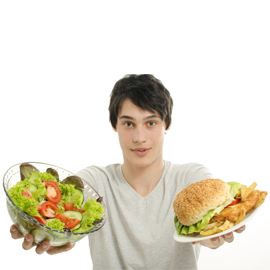Emotional Eating
November 2014
 Sticking to a logical, healthy eating plan can be the key to unlocking your weight loss potential, but for many people, emotional eating can ruin even the best intentions. So what exactly is “emotional eating,” and how can you avoid it?
Sticking to a logical, healthy eating plan can be the key to unlocking your weight loss potential, but for many people, emotional eating can ruin even the best intentions. So what exactly is “emotional eating,” and how can you avoid it?
Physical vs. Emotional Hunger
Physical hunger manifests in the body as a slight pain or discomfort in the stomach. This feeling is a sign that your body is lacking the nutrition it needs to convert to energy. Physical hunger can be satiated by any food, or, if mild, even a glass of water. This kind of hunger, your “true” hunger, will be alleviated by eating something, leaving you feeling satisfied and re-energized.
Emotional hunger, however, is not rooted in the physical body, nor can it be satisfied by a simple, nutritious meal. The impulse to eat comfort food, to eat past the point one is physically full or to eat food that is poor in nutritional value, often stems from a place of emotional pain or discomfort. This kind of “hunger” isn’t actually hunger at all, and getting to the bottom of your emotional impulses can help you to stay on track and meet your weight loss goals.
Knowing Your Triggers
Emotional eating can be triggered by a number of feelings, including:
- Stress. One of the most common triggers, stress-related cravings are triggered by cortisol, the hormone released when your body routinely experiences stressful situations.
- Social situations. It’s far easier to stay quiet and eat a second helping of sugary, fatty snacks than to voice your own weight loss goals to a group of coworkers, or even friends and family.
- Painful emotions. From grief to shame to anger, emotional eating can give you a temporary distraction from thoughts and feelings that bring you pain. In almost every situation, the relief is only temporary though, and you usually feel even worse after indulging in emotional eating.
- Boredom: When you are stuck for something to do, snacking is an easy way to fill some time.
Sticking to Your Plan
Once you know your triggers, you can begin to cope. Try drinking a glass of water when you feel the urge to overeat. Then, think through your current feelings, both physical and emotional. If you’re still experiencing hunger, try a fiber rich snack, like an apple or carrots with hummus. If you’re not hungry at all, focus on the positive steps you’ve been making towards physical activity and a healthier diet. Consider some activities that may engage you until the urge to eat passes. Generally, urges sweep over you like waves so once the biggest urge passes, the rest are easier to control.
Occasional lapses are inevitable in any weight loss program. If you slip, don’t stop your efforts. Accept the slip, learn from it and keep moving forward. Successful weight loss and better health is waiting for you so keep going.

